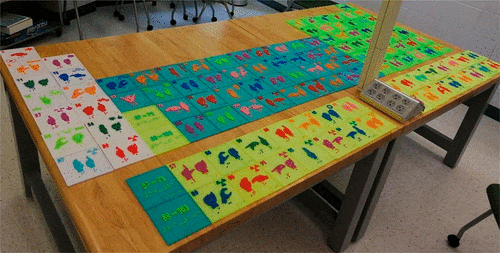Achieving full inclusion for people with disabilities in science, technology, engineering, arts, and mathematics – STEAM – has become a global matter. People with disabilities in STEAM are underrepresented in postsecondary academic environments and the job market. The police killing of George Floyd, an unarmed Black man, in Minneapolis, Minnesota, on May 25th, 2020, was in many ways a catalyst for the global recognition of the need for greater inclusivity. Since then, universities, departments, and individual faculty members have become increasingly committed to improving diversity, inclusivity, and equity (DEI) in academia.

As scientists are reconsidering the ways STEAM is taught, further efforts at inclusivity must focus on the foundational curriculum in education. For example, the periodic table is one of the most important tools in the study of chemistry. Used to provide a great deal of information about chemical elements and how they can relate to one another, this reference is a well-known staple in the science community and contains an arrangement of various elements. Originally the periodic table was designed and arranged by increasing atomic mass but as science has evolved, so have the directives for the periodic arrangement. One avenue for increasing DEI in STEAM is revising learning tools, like the periodic table, to be more accessible to students with disabilities.
Although the periodic table is commonly used to introduce science topics to students, the field has not yet modified it in ways that would make it inclusive to all students. On a traditional periodic table, you can find color-coded element tiles, consisting of a shorthand elemental symbol and an atomic numeric. Scientists with disabilities are not accommodated with the current design. Those who are colorblind or have vision impairments may struggle to see the small elemental tiles. Also, students who struggle with visual disabilities are not able to read it.

Rather than memorizing numbers and chemical structures, students and scientists only need a single glance at the table to learn much about the reactivity of an element. However, students who benefit most from visual learning do not have illustrations to correspond to different elements. A periodic table that takes into account the diversity of learning styles and visual disabilities of current and future differently-abled scientists did not exist.
That was until students from Michigan State University-Saint Andrews along with the Committee on Chemists with Disabilities of the American Chemical Society (ACS), introduced a new element of inclusivity to the science community and the public. Through collaborative efforts, these groups designed a STEAM outreach project that promotes DEI. This project led to the design of the first ever all-inclusive 3D periodic table that was later displayed at several ACS conferences. Over 30 students, aged 7 to 17, participated by selecting at least one element.
Using out-of-the-box thinking, these students collectively designed a 3D periodic table that promotes awareness and accommodates scientists with disabilities. One of the initiatives behind incorporating 3D printing is that it led to real-world experience through hands-on engineering. For example, a student who selected the chemical element gold incorporated the use of a 3D-printed gold chain. This research project challenged students to create a learning activity that addressed inclusivity in STEAM education and caters to different learning styles. Each student designed an element tile that was approximately 5” by 5”, larger than those in traditional periodic tables.

For the elemental lettering, ASL hand signing was used along with Braille at the bottom of each tile. Another consideration was to make the periodic table more culturally inclusive by using numeric systems from other countries, such as Arabic numbering. One of the students stated, “I like the design and printing part of this project and it helped me to understand the obstacles people with disabilities face.” If we want our science to reflect values of diversity and inclusivity, we need to create educational resources that make this possible.
This 3D-inclusive periodic table challenges the traditional ways in which the periodic table is presented and shows that we can change institutional structures to support the learning and development of marginalized scientists. This is vital for the growth of science and science policy as well. This project was a creative way to bring awareness to the importance of making science more inclusive and equitable to students and communities. Ultimately, making science more accessible will foster stronger relationships between scientific communities and the public.
References:
Edited by Elizabeth Rosdeitcher and Brianna Best

Leave a Reply